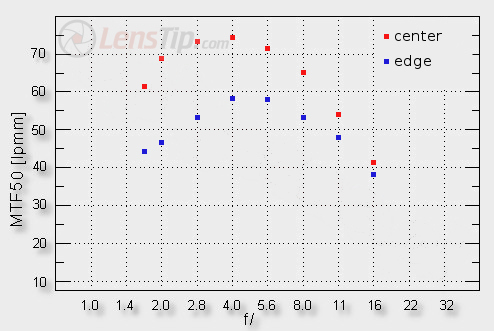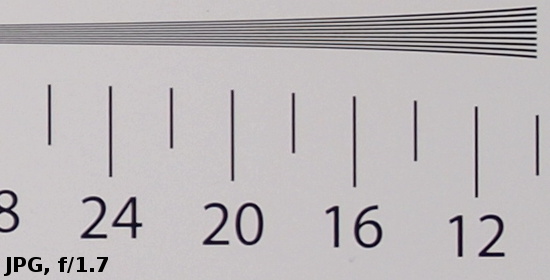Panasonic G 20 mm f/1.7 ASPH.
4. Image resolution
The Micro 4/3 system is aimed at amateur photographers; small wonder there are quite a lot of models and every single one of them can have a slightly different approach to the sensor’s software. In recent cameras we noticed a tendency to a distinct weakening of the AA filter and (perhaps) introducing several other processes. A lens’s test is not a good place for a lengthy discussion about it, though. The important thing is that the MTFs you get in a test conducted on the E-PL1 or G2 are very high indeed.
So far the highest MTF values have been shown by instruments tested on the Olympus E-3 and the Canon 50D where the results could reach even over 50 lpmm. In the case of the newest Micro 4/3 cameras a high pixels density and a weak AA filter among other things make the results exceed the level of 70 lpmm. You must be aware that these high MTFs are not the result of an exceptionally good performance of the lens only, because even an optically weak device at some apertures would reach significantly over 50 lpmm here.
Please Support UsIf you enjoy our reviews and articles, and you want us to continue our work please, support our website by donating through PayPal. The funds are going to be used for paying our editorial team, renting servers, and equipping our testing studio; only that way we will be able to continue providing you interesting content for free. |
- - - - - - - - - - - - - - - - - - - - - - - - - - - - - - - - - - - - - - - - - - - - - - - -
Usually a good reference point in any cross-system comparisons of tests were values obtained at f/16. Only the diffraction limits the performance there so all lenses tested on a given sensor produce more or less the same results. In the case of the tests conducted on the E-PL1 and the G2, lenses stopped down to f/16 reach results of 41-42 lpmm. Let’s consider these values as the decency level in our optics tests then.
After this introduction let’s pass to the results the Panasonic 1.7/20 had on the 12 Mpix sensor of the Olympus E-PL1. Although the full resolution test was based also on the RAW files from the Panasonic G2 we don’t show the values the lens got on that camera. Contrary to the E-PL1 it shows measurable differences between vertical and horizontal MTF50 function values which most probably stem from a different strength of the AA filter. It constitutes a further complication, not useful in any optics tests at all. It will be much easier to interpret the result reached on the E-PL1 and we are going to focus on them. Traditionally, we used RAW files which were processed without sharpening by the dcraw program.

We can only praise the lens’s performance in the frame centre. Even at the maximum relative aperture we get a sharp image because the lens gets to the level of over 60 lpmm - much higher than the decency level. On slight stopping down we enter the area of really high values.
The edge of the frame significantly lags behind the results we saw at the centre. We can’t criticize the Panasonic here though because even at the maximum aperture the values are near 43 lpmm so a bit higher than our reference point. We haven’t seen such results at the edge of the frame in the case of any other system standard lens with comparable fastness.
 |






